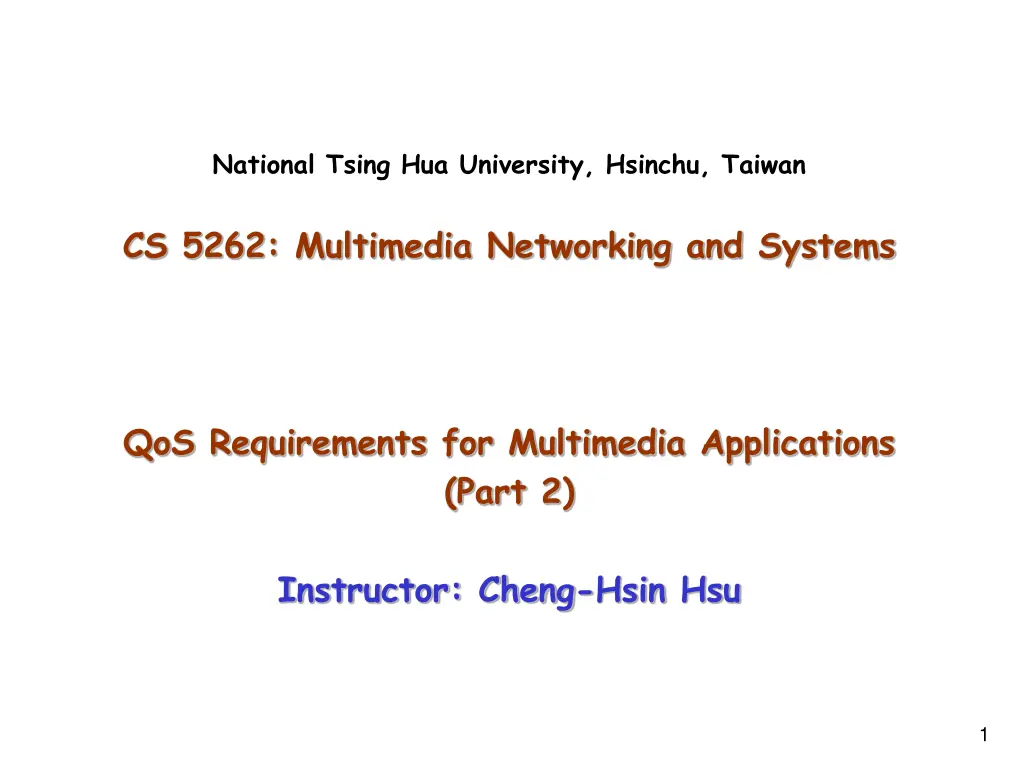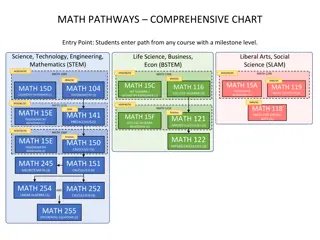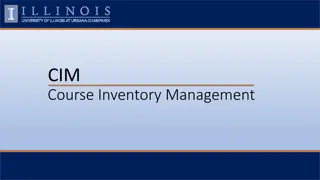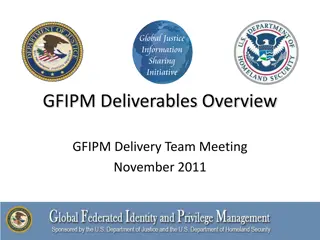
Multimedia Networking Protocols and RTSP in Multimedia Applications
Explore the role of Real-Time Streaming Protocol (RTSP) and other protocols in managing multimedia data, controlling streaming sessions, and enhancing user experience in multimedia applications. Understand the functions and limitations of RTSP, out-of-band control, and examples of metafiles in multimedia communication.
Download Presentation

Please find below an Image/Link to download the presentation.
The content on the website is provided AS IS for your information and personal use only. It may not be sold, licensed, or shared on other websites without obtaining consent from the author. If you encounter any issues during the download, it is possible that the publisher has removed the file from their server.
You are allowed to download the files provided on this website for personal or commercial use, subject to the condition that they are used lawfully. All files are the property of their respective owners.
The content on the website is provided AS IS for your information and personal use only. It may not be sold, licensed, or shared on other websites without obtaining consent from the author.
E N D
Presentation Transcript
National Tsing Hua University, Hsinchu, Taiwan CS 5262: Multimedia Networking and Systems QoS Requirements for Multimedia Applications (Part 2) Instructor: Cheng-Hsin Hsu 1
Protocols For Multimedia Applications To manage and stream multimedia data RTSP: Real-Time Streaming Protocol RTP: Real-Time Protocol RTCP: Real-Time Control Protocol SIP: Session Initiation Protocol 2
Real-Time Streaming Protocol (RTSP) RFC 2326 client-server application layer protocol Used to control a streaming session rewind, fast forward, pause, resume, repositioning, etc What it doesn t do: doesn t define how audio/video is encapsulated for streaming over network doesn t restrict how streamed media is transported (UDP or TCP possible) doesn t specify how media player buffers audio/video 3
RTSP: out of band control RTSP messages also sent out-of-band: RTSP control messages use different port numbers than media stream: out-of-band. port 554 media stream is considered in-band . FTP uses an out-of- band control channel: file transferred over one TCP connection. control info (directory changes, file deletion, rename) sent over separate TCP connection out-of-band , in- band channels use different port numbers 4
RTSP Example metafile communicated to web browser browser launches player player sets up an RTSP control connection, data connection to streaming server 5
Metafile Example <title>Twister</title> <session> <group language=en lipsync> <switch> <track type=audio e="PCMU/8000/1" src = "rtsp://audio.example.com/twister/audio.en/lofi"> <track type=audio e="DVI4/16000/2" pt="90 DVI4/8000/1" src="rtsp://audio.example.com/twister/audio.en/hifi"> </switch> <track type="video/jpeg" src="rtsp://video.example.com/twister/video"> </group> </session> 6
RTSP Exchange Example (simplified) C: SETUP rtsp://audio.example.com/twister/audio RTSP/1.0 Transport: rtp/udp; compression; port=3056; mode=PLAY S: RTSP/1.0 200 OK Session 4231 C: PLAY rtsp://audio.example.com/twister/audio.en/lofi RTSP/1.0 Session: 4231 Range: npt=0- C: PAUSE rtsp://audio.example.com/twister/audio.en/lofi RTSP/1.0 Session: 4231 Range: npt=37 C: TEARDOWN rtsp://audio.example.com/twister/audio.en/lofi RTSP/1.0 Session: 4231 S: 200 OK 8
Real-Time Protocol (RTP): FRC 3550 RTP specifies packet structure for audio and video data payload type identification packet sequence numbering time stamping RTP runs in the end systems RTP packets are encapsulated in UDP segments RTP does not provide any mechanism to ensure QoS RTP encapsulation is only seen at the end systems 9
RTP Header Payload Type (7 bits): Indicates type of encoding currently being used: e.g., Payload type 0: PCM mu-law, 64 kbps Payload type 33, MPEG2 video Sequence Number (16 bits): Increments by one for each RTP packet sent, and may be used to detect packet loss Timestamp field (32 bytes long). Reflects the sampling instant of the first byte in the RTP data packet. SSRC field (32 bits long). Identifies the source of the RTP stream. Each stream in a RTP session should have a distinct SSRC. 10
RTP Example consider sending 64 kbps PCM-encoded voice over RTP. application collects encoded data in chunks, e.g., every 20 msec = 160 bytes in a chunk. audio chunk + RTP header form RTP packet, which is encapsulated in UDP segment RTP header indicates type of audio encoding in each packet sender can change encoding during conference. RTP header also contains sequence numbers, timestamps. 11
Real-Time Control Protocol (RTCP) Also in RFC 3550 (with RTP) works in conjunction with RTP Allows monitoring of data delivery in a manner scalable to large multicast networks Provides minimal control and identification functionality each participant in RTP session periodically transmits RTCP control packets to all other participants. each RTCP packet contains sender and/or receiver reports report statistics useful to application: # packets sent, # packets lost, interarrival jitter, etc. used to control performance, e.g., sender may modify its transmissions based on feedback 12
RTCP - Continued Each RTP session typically uses a single multicast address All RTP/RTCP packets belonging to session use multicast address RTP, RTCP packets distinguished from each other via distinct port numbers To limit traffic, each participant reduces RTCP traffic as number of conference participants increases 13
RTCP Packets Source description packets: e-mail address of sender, sender's name, SSRC of associated RTP stream provide mapping between the SSRC and the user/host name Receiver report packets: fraction of packets lost, last sequence number, average interarrival jitter Sender report packets: SSRC of RTP stream, current time, number of packets sent, number of bytes sent 14
Synchronization of Streams RTCP can synchronize different media streams within an RTP session consider videoconferencing app for which each sender generates one RTP stream for video, one for audio. timestamps in RTP packets tied to the video, audio sampling clocks not tied to wall-clock time each RTCP sender-report packet contains (for most recently generated packet in associated RTP stream): timestamp of RTP packet wall-clock time for when packet was created. receivers uses association to synchronize playout of audio, video 15
RTCP Bandwidth Scaling RTCP attempts to limit its traffic to 5% of session bandwidth. Example Suppose one sender, sending video at 2 Mbps. Then RTCP attempts to limit its traffic to 100 Kbps. RTCP gives 75% of rate to receivers; remaining 25% to sender 75 kbps is equally shared among receivers: with R receivers, each receiver gets to send RTCP traffic at 75/R kbps. sender gets to send RTCP traffic at 25 kbps. participant determines RTCP packet transmission period by calculating avg RTCP packet size (across entire session) and dividing by allocated rate 16
SIP: Session Initiation Protocol[RFC 3261] SIP long-term vision: all telephone calls, video conference calls take place over Internet people are identified by names or e-mail addresses, rather than by phone numbers you can reach callee, no matter where callee roams, no matter what IP device callee is currently using 17
SIP Services determine current IP address of callee: maps mnemonic identifier to current IP address call management: add new media streams during call change encoding during call invite others transfer, hold calls Setting up a call, SIP provides mechanisms ... for caller to let callee know she wants to establish a call so caller, callee can agree on media type, encoding to end call 18
Setting up a call to known IP address Alice s SIP invite message indicates her port number, IP address, encoding she prefers to receive (PCM ulaw) Bob Alice 167.180.112.24 193.64.210.89 INVITE bob@193.64.210.89 c=IN IP4 167.180.112.24 m=audio 38060 RTP/AVP 0 Bob s 200 OK message indicates his port number, IP address, preferred encoding (GSM) port 5060 Bob's terminal rings 200 OK c=IN IP4 193.64.210.89 m=audio 48753 RTP/AVP 3 port 5060 ACK port 5060 SIP messages can be sent over TCP or UDP; here sent over RTP/UDP. default SIP port number is 5060. m Law audio port 38060 GSM port 48753 time time 19
Setting up a call (more) codec negotiation: suppose Bob doesn t have PCM ulaw encoder Bob will instead reply with 606 Not Acceptable Reply, listing his encoders Alice can then send new INVITE message, advertising different encoder rejecting a call Bob can reject with replies busy, gone, payment required, forbidden media can be sent over RTP or some other protocol 20
Example of SIP message INVITE sip:bob@domain.com SIP/2.0 Via: SIP/2.0/UDP 167.180.112.24 From: sip:alice@hereway.com To: sip:bob@domain.com Call-ID: a2e3a@pigeon.hereway.com Content-Type: application/sdp Content-Length: 885 Here we don t know Bob s IP address. Intermediate SIP servers needed. Alice sends, receives SIP messages using SIP default port 5060 c=IN IP4 167.180.112.24 m=audio 38060 RTP/AVP 0 Notes: HTTP message syntax sdp = session description protocol Call-ID is unique for every call. Alice specifies in header that SIP client sends, receives SIP messages over UDP 21
Name translation and user locataion caller wants to call callee, but only has callee s name or e-mail address. need to get IP address of callee s current host: user moves around DHCP protocol user has different IP devices (PC, PDA, car device) result can be based on: time of day (work, home) caller (don t want boss to call you at home) status of callee (calls sent to voicemail when callee is already talking to someone) Service provided by SIP servers: SIP registrar server SIP proxy server 22
SIP Registrar when Bob starts SIP client, client sends SIP REGISTER message to Bob s registrar server (similar function needed by Instant Messaging) Register Message: REGISTER sip:domain.com SIP/2.0 Via: SIP/2.0/UDP 193.64.210.89 From: sip:bob@domain.com To: sip:bob@domain.com Expires: 3600 23
SIP Proxy Alice sends invite message to her proxy server contains address sip:bob@domain.com proxy responsible for routing SIP messages to callee possibly through multiple proxies. callee sends response back through the same set of proxies. proxy returns SIP response message to Alice contains Bob s IP address proxy analogous to local DNS server 24
Example Caller jim@umass.edu with places a call to keith@upenn.edu SIP registrar upenn.edu SIP registrar eurecom.fr 2 SIP proxy umass.edu (1) Jim sends INVITE message to umass SIP proxy. (2) Proxy forwards request to upenn registrar server. (3) upenn server returns redirect response, indicating that it should try keith@eurecom.fr (4) umass proxy sends INVITE to eurecom registrar. (5) eurecom registrar forwards INVITE to 197.87.54.21, which is running keith s SIP client. (6-8) SIP response sent back (9) media sent directly between clients. Note: also a SIP ack message, which is not shown. 3 4 1 5 7 8 6 9 SIP client 197.87.54.21 SIP client 217.123.56.89 25
Comparison with H.323 H.323 is another signaling protocol for real-time, interactive H.323 is a complete, vertically integrated suite of protocols for multimedia conferencing: signaling, registration, admission control, transport, codecs SIP is a single component. Works with RTP, but does not mandate it. Can be combined with other protocols, services H.323 comes from the ITU (telephony). SIP comes from IETF: Borrows much of its concepts from HTTP SIP has Web flavor, whereas H.323 has telephony flavor. SIP uses the KISS principle: Keep it simple stupid. 26
Summary: Protocols Several protocols to handle multimedia data RTP: Real-Time Protocol Packetization, sequence number, time stamp RTSP: Real-Time Streaming Protocol Establish, Pause, Play, FF, Rewind RTCP: Real-Time Control Protocol Control and monitor sessions; synchronization SIP: Session Initiation Protocol Establish and manage VoIP sessions Simpler than the ITU H.323 NONE enforces QoS in the network 27






















